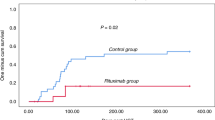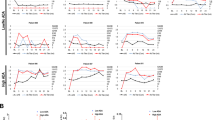Abstract
The activity of the autoimmune mechanism underlying type 1 diabetes mellitus (T1DM) can be suppressed when immunoablation and autologous hematopoietic stem cell transplantation (AHSCT) are applied early in the course of the disease. We report here a single centre experience with this treatment modality. Twenty-four patients underwent a AHSCT preceded by immunoablative conditioning with high-dose cyclophosphamide and anti-thymocyte globulin. During the 52-month median time of follow-up 20 out of 23 patients (87%) remained for at least 9.5 months without the use of exogenous insulin. The median time of T1DM remission for these patients was 31 months (range of 9.5–80 months). Among the patients available for follow-up (n=20), four remain insulin free (for 80, 61, 42 and 34 months). The average glycated hemoglobin (HbA1c) concentrations were 10.9% at diagnosis, 5.9% at 1 year, 6.4% at 2 years, 6.8% at 3 years and 7.1% at 4 years after AHSCT. No severe complications of diabetes were seen, however one of the patients died of pseudomonas sepsis in the course of neutropenia after AHSCT. AHSCT leads to a remission of T1DM with good glycemic control in the vast majority of patients, with the period of remission lasting over 5 years in some patients.
This is a preview of subscription content, access via your institution
Access options
Subscribe to this journal
Receive 12 print issues and online access
$259.00 per year
only $21.58 per issue
Buy this article
- Purchase on Springer Link
- Instant access to full article PDF
Prices may be subject to local taxes which are calculated during checkout

Similar content being viewed by others
References
Harrison LC, Colman PG, Dean B, Baxter R, Martin FI . Increase in remission rate in newly diagnosed type 1 diabetic subjects treated with azathioprine. Diabetes 1985; 34: 1306–1308.
Silverstein J, Maclaren N, Riley W, Spillar R, Radjenovic D, Johnson S . Immunosupression with azatioprine and prednisone in recent-onset insulin-dependent diabetes mellitus. N Engl J Med 1988; 319: 599–604.
Cyclosporin-induced remission of IDDM after early intervention. association of 1yr of cyclosporin treatment with enhanced insulin secretion. Canadian–European Randomized Control Trial Group. Diabetes 1988; 37: 1574–1582.
Pescovitz MD, Greenbaum CJ, Bundy B, Becker DJ, Gitelman SE, Goland R et al. Type 1 Diabetes TrialNet Anti-CD20 Study Group. B-lymphocyte depletion with rituximab and β-cell function: two-year results. Diabetes Care 2014; 37: 453–459.
Herold KC, Hagopian W, Auger JA, Poumian-Ruiz E, Taylor L, Donaldson D et al. Anti-CD3 monoclonal antibody in new-onset type 1 diabetes mellitus. N Engl J Med 2002; 346: 1692–1698.
Sherry N, Hagopian W, Ludvigsson J, Jain SM, Wahlen J, Ferry RJ Jr et alProtégé Trial Investigators. Teplizumab for treatment of type 1 diabetes (Protégé study): 1-year results from a randomized, placebo-controlled trial. Lancet 2011; 378: 487–497.
Wherrett DK, Bundy B, Becker DJ, DiMeglio LA, Gitelman SE, Goland R et alType 1 Diabetes TrialNet GAD Study Group. Antigen-based therapy with glutamic acid decarboxylase (GAD) vaccine in patients with recent-onset type 1 diabetes: a randomised double-blind trial. Lancet 2011; 378: 319–327.
Haller MJ, Wasserfall CH, Hulme MA, Cintron M, Brusko TM, McGrail KM et al. Autologous umbilical cord blood infusion followed by oral docosahexaenoic acid and vitamin D supplementation for C-peptide preservation in children with Type 1 diabetes. Biol Blood Marrow Transplant 2013; 19: 1126–1129.
Voltarelli JC, Couri CE, Stracieri AB, Oliveira MC, Moraes DA, Pieroni F et al. Autologous nonmyeloablative hematopoietic stem cell transplantation in newly diagnosed type 1 diabetes mellitus. JAMA 2007; 297: 1568–1576.
Snarski E, Milczarczyk A, Torosian T, Paluszewska M, Urbanowska E, Król M et al. Independence of exogenous insulin following immunoablation and stem cell reconstitution in newly diagnosed diabetes type 1. Bone Marrow Transplant 2011; 46: 562–566.
Gu W, Hu J, Wang W, Li L, Tang W, Sun S et al. Diabetic ketoacidosis at diagnosis influences complete remission after treatment with hematopoietic stem cell transplantation in adolescents with type 1 diabetes. Diabetes Care 2012; 35: 1413–1419.
Li L, Shen S, Ouyang J, Hu Y, Hu L, Cui W et al. Autologous hematopoietic stem cell transplantation modulates immunocompetent cells and improves β-cell function in Chinese patients with new onset of type 1 diabetes. J Clin Endocrinol Metab 2012; 97: 1729–1736.
Zhang X, Ye L, Hu J, Tang W, Liu R, Yang M et al. Acute response of peripheral blood cell to autologous hematopoietic stem cell transplantation in type 1 diabetic patient. PLoS ONE 2012; 7: e31887.
D'Addio F, Valderrama Vasquez A, Ben Nasr M, Franek E, Zhu D, Li L et al. Autologous nonmyeloablative hematopoietic stem cell transplantation in new-onset type 1 diabetes: a multicenter analysis. Diabetes 2014; 63: 3041–3046.
Snarski E, Szmurło D, Hałaburda K, Król M, Urbanowska E, Milczarczyk A et al. An economic analysis of autologous hematopoietic stem cell transplantation (HSCT) in the treatment of new onset type 1 diabetes. Acta Diabetol 2015; 52: 881–888.
Melanson SE, Stevenson K, Kim H, Antin JH, Court MH, Ho VT et al. Allelic variations in CYP2B6 and CYP2C19 and survival of patients receiving cyclophosphamide prior to myeloablative hematopoietic stem cell transplantation. Am J Hematol 2010; 85: 967–971.
Dave SD, Trivedi HL, Chooramani SG, Chandra T . Management of type 1 diabetes mellitus using in vitro autologous adipose tissue trans-differentiated insulin-making cells. BMJ Case Rep 2013; 2013 pii: bcr2013200226.
Dahlquist G, Källén B . Mortality in childhood-onset type 1 diabetes: a population-based study. Diabetes Care 2005; 28: 2384–2387.
Acknowledgements
We thank Małgorzata Marczewska for her editorial help in the preparation of this manuscript.
Author information
Authors and Affiliations
Corresponding author
Ethics declarations
Competing interests
The authors declare no conflict of interest.
Rights and permissions
About this article
Cite this article
Snarski, E., Milczarczyk, A., Hałaburda, K. et al. Immunoablation and autologous hematopoietic stem cell transplantation in the treatment of new-onset type 1 diabetes mellitus: long-term observations. Bone Marrow Transplant 51, 398–402 (2016). https://doi.org/10.1038/bmt.2015.294
Received:
Revised:
Accepted:
Published:
Issue Date:
DOI: https://doi.org/10.1038/bmt.2015.294
This article is cited by
-
Investigating the safety and efficacy of hematopoietic and mesenchymal stem cell transplantation for treatment of T1DM: a systematic review and meta-analysis
Systematic Reviews (2022)
-
Targeted stem-cell attack could make transplants safer
Nature (2019)
-
Combination Immunotherapy for Type 1 Diabetes
Current Diabetes Reports (2017)
-
Immune Intervention and Preservation of Pancreatic Beta Cell Function in Type 1 Diabetes
Current Diabetes Reports (2016)



